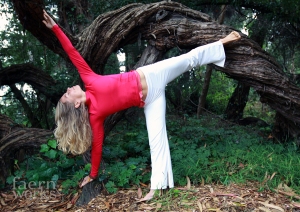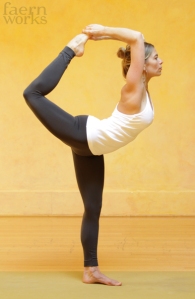POSE OF THE MONTH: Mayurasana (Peacock Pose)
with chrisandra fox
Mayurasana – the powerful peacock pose – practiced regularly, can cultivate tejas, inner radiance and the subtle, yet powerful essence of fire that governs higher perception and the unfolding of spiritual potential.
Tejas, expressed as vital energy, courage, valor, fearlessness, radiance, warmth, light, and the splendor of personality that draws all hearts together, can burn through toxicity of emotion and experience. Strong tejas helps us digest air, thoughts and sensory impressions, and gives us the fearlessness to perform great acts of courage.
Practicing this pose will tone your arms, develop your physical form and increase your vitality. Mayurasana strengthens the forearms, wrists and hands, abdominal muscles, and entire back body. A steady diet of mayurasana can increase digestive power by strengthening samana vayu, or the “balancing air” of the five pranavayus. It is said that the peacock can ingest poison, and this pose, developed properly, can prevent the accumulation of toxicity in the body and mind.
The intra-abdominal pressure of the elbows tones the organs by concentrating blood there and increases agni, the metabolic fire which leads to digestive prowess in metabolizing food, emotions, and experience.
When we challenge ourselves in a pose like mayurasana, we develop the courage and force necessary to develop tapas, the fire or austerity we need in order to fulfill spiritual practice that transforms.
Mayurasana requires great concentration in order to achieve the balance necessary to support the body on two hands. This concentration can lead to clarity of mind that allows our inner fire to burn brightly without becoming dim or damp from distracting thoughts or behaviors. This clarity brings about discriminating wisdom, or viveka.
When you practice Mayurasana every day, or a few days a week, this discernment becomes very clear. The daily rhythm – what we ate the night before, how well we slept, how we’ve used our body, what shoes we wear (and how they affect the body), our mood and emotional state – becomes very apparent. This can lead us to make changes in our lives that are in greater alignment with our higher vision or sense of purpose.
Too much fire without a strong container can cause the tissues to burn, or the mind to become incensed. It is helpful to cultivate compassion, humility, non-judgment, and a sense of humor as you develop the strength of will, fire, and courage in a practice that leads to greater radiance of vitality.
The peacock symbolizes immortality and love. As you practice, you may want to offer up your efforts towards the benefit of others, grounding your spiritual aspirations and progress in practice in compassion, gratitude, and benevolence.
Preparation
Warm up your body and breath with sun salutations, including catturanga dandasana, and joint opening exercises that include wrist circles and stretches. Have an empty belly, a wall, and two blocks. Women, avoid this pose throughout your moon cycle.
You’ll support your feet and head with the blocks as you work slowly over time to strengthen your wrists, arms, abdomen, back, legs, and inner fire.
The Pose
Place a block at the wall, and a second block your body’s length from the wall.
Kneel at the end of your mat near the wall, with your big toes together and knees placed widely apart. Turn your hands on the floor so that your fingers point toward your torso, palms facing down. You’ll bring the pinky fingers together, and draw your forearms and elbows in toward one another.
Lower your forehead to rest on the block at the front of your mat. Exhale your breath, round your spine, and draw your elbows into your low belly. Keep your hands on the floor. Take a moment here to soften your belly and allow your elbow points to sink into your abdomen below your navel. After an exhalation, firm your belly, place your toes on the block, and press back through your feet, thrusting your heels against the wall. Steady with your breath, inhale and lift your head, placing your chin back on the block.
Gaze toward the tip of your nose to help focus your concentration as you draw your elbows in and balance the weight of your body evenly throughout your hands and feet. Grip your finger pads against the floor to create more action in your arms and shoulders. On an exhalation, move your tailbone more deeply into your body and lean your weight slightly more forward. From here, you can play with lifting your head and feet off the blocks. Try pointing through your toes.
Some teach to hold peacock during the single retention of the breath, a short hold repeated several times. In Light on Yoga, BKS Iyengar suggests you build your endurance in the pose, breathing steadily throughout to avoid creating too much pressure in your heart. To an extent, the proportion of your body may determine your longevity in the pose. Practice with patience and dedicated effort – build your fire slowly each day, feel the afterglow of your work.
As your steadiness in mayurasana grows, harness the subtle energy of heat and light, working in a way that nurtures your courage, valor, and radiance to spread throughout your peacock feathers, and to all parts of your life.
Modifications and Variations
- Place elbows below the navel, to the sides of the navel, or above the navel at the diaphragm.
- Loop a strap around your forearms for stability.
- This pose is particularly challenging for women. For managing the breasts, scoop them in between your upper arms, and place your elbows just outside your navel. Focus on creating stability in your forearms and work with great enthusiasm in your legs to help balance the weight of your chest.
- If you have a lotus pose, try practicing Padma mayurasana. Take padmasana (Lotus Pose). Lift to your knees and place your hands in position for mayurasana. Place your forehead on the floor and lower your belly to your elbows. Inhale and lift your lotus legs and head simultaneously, balancing your weight.
Chrisandra Mayurasana and other tejas-building practices 6 days a week at three Yoga Tree studios. Click here for her schedule. She also leads The Heart of Renewal Retreats at Tara Bella Villa in Glen Ellen.
Photography by Faernworks, Faernworks.com
also posted at:
http://www.yogatreesf.com/newsletter/images/sep10_pose.html









